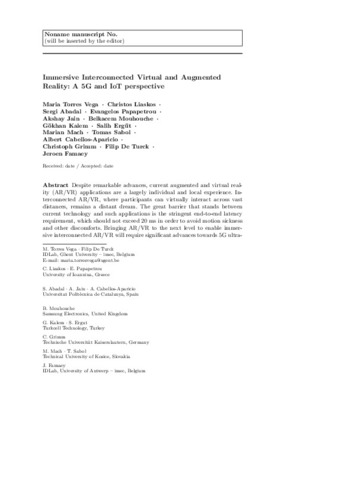Mostra el registre d'ítem simple
Immersive interconnected virtual and augmented reality: a 5G and IoT perspective
| dc.contributor.author | Torres Vega, Maria |
| dc.contributor.author | Liaskos, Christos |
| dc.contributor.author | Abadal Cavallé, Sergi |
| dc.contributor.author | Papapetrou, Evangelos |
| dc.contributor.author | Jain, Akshay |
| dc.contributor.author | Mouhouche, Belkacem |
| dc.contributor.author | Kalem, Gokhan |
| dc.contributor.author | Ergüt, Salih |
| dc.contributor.author | Mach, Marian |
| dc.contributor.author | Sabol, Tomas |
| dc.contributor.author | Cabellos Aparicio, Alberto |
| dc.contributor.author | Grimm, Christoph |
| dc.contributor.author | De Turck, Filip |
| dc.contributor.author | Famaey, Jeroen |
| dc.contributor.other | Universitat Politècnica de Catalunya. Departament d'Arquitectura de Computadors |
| dc.date.accessioned | 2020-10-09T15:03:18Z |
| dc.date.available | 2021-06-12T00:31:13Z |
| dc.date.issued | 2020-01-01 |
| dc.identifier.citation | Torres, M. [et al.]. Immersive interconnected virtual and augmented reality: a 5G and IoT perspective. "Journal of network and systems management", 1 Gener 2020, núm. 28, p. 796-826. |
| dc.identifier.issn | 1064-7570 |
| dc.identifier.uri | http://hdl.handle.net/2117/330129 |
| dc.description | The final publication is available at Springer via http://dx.doi.org/10.1007/s10922-020-09545-w |
| dc.description.abstract | Despite remarkable advances, current augmented and virtual reality (AR/VR) applications are a largely individual and local experience. Interconnected AR/VR, where participants can virtually interact across vast distances, remains a distant dream. The great barrier that stands between current technology and such applications is the stringent end-to-end latency requirement, which should not exceed 20 ms in order to avoid motion sickness and other discomforts. Bringing AR/VR to the next level to enable immersive interconnected AR/VR will require significant advances towards 5G ultra-reliable low-latency communication (URLLC) and a Tactile Internet of Things (IoT). In this article, we articulate the technical challenges to enable a future AR/VR end-to-end architecture, that combines 5G URLLC and Tactile IoT technology to support this next generation of interconnected AR/VR applications. Through the use of IoT sensors and actuators, AR/VR applications will be aware of the environmental and user context, supporting human-centric adaptations of the application logic, and lifelike interactions with the virtual environment. We present potential use cases and the required technological building blocks. For each of them, we delve into the current state of the art and challenges that need to be addressed before the dream of remote AR/VR interaction can become reality. |
| dc.description.sponsorship | Maria Torres Vega is funded by the Research Foundation Flanders (FWO), grant number 12W4819N. This work has been partially supported by the Spanish Ministry of Economy and Competitiveness under contract TEC2017-90034-C2-1-R (ALLIANCE project) that receives funding from FEDER |
| dc.format.extent | 31 p. |
| dc.language.iso | eng |
| dc.subject | Àrees temàtiques de la UPC::Enginyeria de la telecomunicació::Radiocomunicació i exploració electromagnètica::Comunicacions mòbils |
| dc.subject | Àrees temàtiques de la UPC::Enginyeria de la telecomunicació::Telemàtica i xarxes d'ordinadors::Internet |
| dc.subject.lcsh | Mobile communication systems |
| dc.subject.lcsh | Internet of things |
| dc.subject.other | Augmented and virtual reality |
| dc.subject.other | Tactile Internet |
| dc.subject.other | 5G |
| dc.subject.other | Internet of things |
| dc.title | Immersive interconnected virtual and augmented reality: a 5G and IoT perspective |
| dc.type | Article |
| dc.subject.lemac | Comunicacions mòbils, Sistemes de |
| dc.subject.lemac | Internet de les coses |
| dc.contributor.group | Universitat Politècnica de Catalunya. CBA - Sistemes de Comunicacions i Arquitectures de Banda Ampla |
| dc.contributor.group | Universitat Politècnica de Catalunya. WNG - Grup de xarxes sense fils |
| dc.identifier.doi | 10.1007/s10922-020-09545-w |
| dc.description.peerreviewed | Peer Reviewed |
| dc.relation.publisherversion | https://link.springer.com/article/10.1007%2Fs10922-020-09545-w |
| dc.rights.access | Open Access |
| local.identifier.drac | 29187712 |
| dc.description.version | Postprint (published version) |
| dc.relation.projectid | info:eu-repo/grantAgreement/AEI/Plan Estatal de Investigación Científica y Técnica y de Innovación 2013-2016/TEC2017-90034-C2-1-R/ES/DISEÑANDO UNA INFRAESTRUCTURA DE RED 5G DEFINIDA MEDIANTE CONOCIMIENTO HACIA LA PROXIMA SOCIEDAD DIGITAL/ |
| local.citation.author | Torres, M.; Liaskos, C.; Abadal, S.; Papapetrou, E.; Jain, A.; Mouhouche, B.; Kalem, G.; Ergüt, S.; Mach, M.; Sabol, T.; Albert Cabellos-Aparicio; Grimm, C.; De Turck, F.; Famaey, J. |
| local.citation.publicationName | Journal of network and systems management |
| local.citation.number | 28 |
| local.citation.startingPage | 796 |
| local.citation.endingPage | 826 |
Fitxers d'aquest items
Aquest ítem apareix a les col·leccions següents
-
Articles de revista [1.049]
-
Articles de revista [141]
-
Articles de revista [154]


